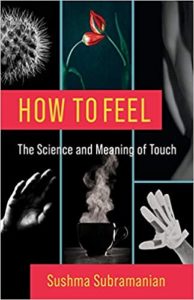
What Happens When We Are
Deprived of Touch?
Sushma Subramanian on the Paradoxes of Solitude and Intimacy
There were a long few years when I was making a living as a full-time magazine freelancer that I was mostly without significant contact with another person. I worked alone. I ate alone. I went to bed alone. I had roommates who were busy with their jobs and with whom I’d chat on their way in and out, and I had a circle of people I’d meet with in the evenings, but most of my dearest friends and family were a phone call away. I spent the majority of my time in my head and in my work, which isn’t to say I was lonely or depressed. I enjoyed it. I love spending time by myself. But I started to wonder if it even mattered that I was there, that I existed.
I asked myself why I even lived where I did, the way I did. I could have moved anywhere and continued in pretty much the same fashion. My daily practices reflected the way I thought about my physical presence in the world. Like many people who work from home, I lived in sweats. It didn’t matter if I showered. It became easy for me to forget to drink water or to sleep since I was so absorbed in the screen in front of me. I had to set reminders on my phone to get up and exercise so I could remain a functioning human. I did it because I knew it was good for me, but I hardly ever felt the urge. There was no inner voice telling me to go out and remind myself my body was alive.
This pattern of daily life was my norm when I started dating my now-husband, Kartik. I met him the way most people do these days, which is online. We’re both inherently reserved people, so while we could charm our way through our first conversations, physical contact came slowly. We inched closer and closer to each other while sitting on a couch. I’d place a hand on his shoulder when he told a joke. I remember when we held hands for the first time while together at his apartment. It was like an electrical current ran up my arm and dislodged something in my throat. I didn’t know how much I needed that touch, how hungry my skin was for it. Something in me came awake that day. I ate better. I slept better. I’ve gone back to that moment repeatedly while writing this book, and now I see how much of what I was feeling is so common in today’s environment.
How we use our senses isn’t just biological. It’s shaped by lessons from our culture. In the West, we favor vision, which means that physical presence, which touch epitomizes, fades away. While we’ve surrounded ourselves with interesting sights and sounds, our tactile existence has become comparatively bare. We don’t very often feel the satisfaction of building something with our own hands or the revolving temperatures of the seasons or the security of a doctor consoling us when we’re sick. Since we live without these sensations, we hardly recognize that we miss them, and we don’t think about what it would mean to try to preserve them. To understand how we got here, we have to go back hundreds of years, all the way to the ancient Greeks.
Ever since Plato, touch has been an unappreciated sense. For him, ranking the senses from highest to lowest was a central exercise in examining what makes humans different from the rest of the animal kingdom. If an aptitude for higher thought is what sets us apart from the lower creatures, which have only basic bodily awareness, then the senses could be hierarchically arranged, from those that are the most aligned with the mind to those most concerned with the corporeal. Vision, as a way of experiencing the world that operates at a physical remove, allows for cool reason, Plato thought. He put it at the top. Touch is immediate and visceral. It is concerned with gutlevel needs, basic survival, and sexual temptation. It ranked as the lowest.
My daily practices reflected the way I thought about my physical presence in the world.
But even as Plato denigrated touch, his feelings about it weren’t absolute. He used it to describe the moment when the soul made contact with the divine. Aristotle thought the universality of touch was an indication of its importance and power; it’s how animals are able to recognize their own existence, and humans’ superior thought helped to form a capacity for mental self-reflection. Touch has been considered by philosophers, writers, and artists as a powerful sense because it tells us the truth when our eyes deceive us. If vision is associated with knowledge, then touch is most representative of affect. When we meet an unfriendly person, we describe them as “cold.” When an experience moves us, it is “touching.” We draw these links in part because our emotions are expressed through physical changes in our skin. If we subtract all the other bodily sensations from an emotion such as anger—the pulsing of a heartbeat, the deepening of the breath, the heat rising in our skin—it’s doubtful whether the emotion would even be recognizable to us anymore.
We’ve carried these mixed messages about touch with us through the ages, and we perpetuate them without realizing it. Plato’s mind/body dualism fed into Christian moralizing of vision as beautiful and godly and touch as dirty, the seat of our passions. At the same time, there are numerous examples of divine touch for healing. During the Enlightenment, methods of learning that used vision, such as reading and observing, were idealized. The act of seeing became symbolic of knowledge itself. Concurrently, as touching acquaintances became rarer, literature romanticized subtle touches between love interests. They were portrayed as magical and soul-churning. The Industrial Age was a period that saw the replacement of hand-held tools with large machines, and it launched a counter-response—the Arts and Crafts movement, which aimed to bring back a respect for the intricacy and imperfection of human handiwork.
These contrasting feelings about our sense of touch, as an unsophisticated sense but also one with unique access to the psyche, molds our products and practices today. Our machines are mostly flat boxes with pictures, and there are few moments when we aren’t gazing upon their blue glow. They don’t ask us to push levers and buttons and materially interact with them the way our machines did even thirty years ago. These same machines are sold to us as a way to stay constantly connected to our loved ones and to build community. Tactile words are even used to make it seem more human: iPod Touch and HP Touch Pad. We form our egos around our highly curated visual personas that we exchange on them, but these images don’t compare to being together in the flesh. We’re conflicted about what our computers and cell phones do for us—keep us together or strip us of intimacy and empathy.
Our ambivalence regarding touch is observable in the way we conduct our relationships. Smaller households, delayed marriage, and longer life expectancy mean we don’t have the physical closeness that we would have expected in the past. As touch has become sexualized in American culture in the past few decades, we’ve demonized it in most other personal and professional settings. Fears about lawsuits and the rise of the #MeToo movement have made us avoid any interactions that might hint toward inappropriateness. Because affectionate touch tends to be reserved for only for our most intimate relationships—with exceptions depending on our culture, gender, and personality—many people don’t receive any. It’s not yet clear whether our etiquette is protecting us or alienating us from each other.
Several prominent voices are crying out about how our growing detachment is making us less able to handle the challenges of living and working beside other people. We openly talk about our epidemic of loneliness, including our lack of tactile bonding, and how it’s leading to chronic illness. Our era has even been termed as the Age of Excarnation, a time when we’re living outside of our bodies, meaning we observe ourselves more as externalized images than as living skin and bone. When we put a finger on the pulse of the culture, we find that our daily lives are telling us that we’re disembodied eyes and brains. Virtual reality beckons as a final invitation to leave our lived environments and escape into another without any of the friction of real life.
Touch has been considered by philosophers, writers, and artists as a powerful sense because it tells us the truth when our eyes deceive us.
We have a deep anxiety about an increasingly visual world. While we’ve long been reckoning with these issues personally and socially for centuries, today a vast area of research is reminding us how important touch is. When we’re babies, our parents’ touch is how we know that we’re cared for, and it’s crucial to our physical growth and emotional development. Through it, we develop our understanding of what it means to be separate and yet connected. Touch is our first way of exploring the world. As we bump up against our surroundings, we get a sense of the limits of our bodies and how we can use them to extend our will. The subtle signals from touch help us learn to walk, to pick up objects, and to solve our first basic problems. The senses of vision and touch act as a check-and-balance system through which we arrive at a compromise between our peripheral realities and our deeper wants.
The sensations we receive through touch form a profound form of knowledge that usually take place outside our consciousness, which is why we fail to appreciate them. Many scientists believe that working with our bodies, particularly our highly sensitive hands, is how humans laid the groundwork to build technology and the framework for symbolic thought, and perhaps even our language. In other words, we built atop our skills for physical invention the ability to tinker and toy with ideas solely in our minds. Some believe we’re doing ourselves a disservice by failing to use the hands-on learning that served us so well in the past. Children especially might lack engagement when they’re so focused on reading and memorizing books.
Caring, friendly touch helps us act more cooperatively and curbs our more aggressive tendencies. In studying the growing epidemic of loneliness in Western countries, psychologists increasingly focus on our lack of touch and not just the problem of having no one to talk to. We’re recognizing that some people have such a deep need for physical contact that a lack of it can contribute to depression, trouble empathizing with others, and a compromised immune system. This collection of symptoms is seen in a condition that has been called skin hunger. Avoiding touching altogether may make some social situations easier, but if we don’t allow ourselves some of the discomfort of closeness, then we also can’t experience its rewards. We forget the importance of small pats on the back and hand squeezes. It isn’t until we go without them for a long time and someone touches us again that we even notice what we’re missing.
Even small touches can elicit meaningful emotions and affect our values, and consumer goods companies are taking notice. They are using the latest research on how the sense works and how to appeal to it, incorporating new materials and designs meant to increase our enjoyment of our products. The quirky field of haptics, which is trying to bring more physicality to our technology, is now experiencing a golden age that could change the way we all use our sense of touch with our devices. Haptics engineers are thinking about how to replace the feelings, such as typing and the turning of dials, that we used to get from our machines so we have a deeper connection to them. The popularity of touch screens, which allow us to interact directly with images, offers up possibilities for an entirely new library of sensations to develop.
I don’t remember exactly when I started thinking about touch. But one vague memory sticks out, when I was procrastinating on my work one day. The top of my desk was feeling a little loose, so I stood up and tried to lift it off its base to see which one of the screws needed tightening. As my fingers curled around the corner, I noticed all the information that I was taking in, from the graininess of the wood, to the strain of my muscles, to the pinching of my skin. All of these subtle cues helped me figure out the answer. I started to wonder which of these sensations were part of my sense of touch. Was it just what I felt on my skin? Or was it all of them together?
It was unsettling to realize how little I knew about my sense of touch, considering it’s a capacity that never shuts off. What I’d learned back in school felt profoundly incomplete. Since kindergarten, I’d thought of it simply as how I feel. It’s how I could tell without looking that I’d landed my feet securely on the pedals of my bike. It was the itch of a bug bite. It was the agonizing pain of stubbing my little toe. It was the scratchy kiss of an overworn sweater. It was the relief of leaning my head on a friend’s shoulder. But coming up with a working definition of touch is far more complicated than it might seem initially. In fact, even scientists still disagree on how to go about it. They’re not even sure if it’s just one sense or a cluster of many.
These contrasting feelings about our sense of touch, as an unsophisticated sense but also one with unique access to the psyche, molds our products and practices today.
Although touch has always been a sense with a shaky definition, these debates became much more prominent with the invention of electron microscopy in the twentieth century, which has made it possible to see the wide array of structures in our bodies that are devoted to our sense of touch. Of all the senses, touch continues to be the least understood because it has so many components that are difficult to isolate. But it’s not just science that gets to characterize touch for us. Classical Western philosophy has been committed to the idea of five basic senses for centuries. According to our cultural understanding of touch, it seems obvious to us that temperature and itch and pain and pressure are all parts of touch and help create our perceptions of our bodies’ movement through space. This is how we’ll examine it here.
Touch was an unexpected subject for me, mostly because I’ve never really liked it that much. When I was younger, my father used to call me a “touch-me-not” after the fern that folds in on itself when it’s stroked because I had a tendency to shrink away when anyone came too close. I’ve never developed the ease with my body that some people have with theirs, although I’ve since mostly outgrown my extreme aversion. I’m happy to shake hands or hug if someone else initiates. There are some people I do touch voluntarily. I like to touch Kartik. But I think my lifelong squeamishness around touch is another reason I was drawn to this subject. It probably takes someone with strong feelings around touch to even notice it since it’s a sense that so often operates in the background.
Growing up as a child of Indian immigrants, I was also acutely aware of the way my tactile interactions with my family differ from those of my peers and their families. We ate rice with our hands instead of a fork and nodded our heads to greet relatives instead of hugging them. I got the impression that how my two cultures use touch differently says a lot about them. When I switched between these two ways of acting, I noticed small shifts in my thinking about issues such as hygiene and politeness and how to exist as an individual while being part of a group. The way we use our bodies is so often a physical representation of our internalized states of being.
Haptics engineers are thinking about how to replace the feelings, such as typing and the turning of dials, that we used to get from our machines so we have a deeper connection to them.
I started this project with basic questions about what touch is and how it works. Over time my questions became more personal and more pressing. I began considering all of the cultural programming that led me to my unique relationship with touch, numerous examples of which are fairly universal. When we’re young and are warned to “keep your hands to yourself” or told that we are “ just being sensitive,” we’re conditioned to think of touch—and its outgrowth, our feelings—as crass and weak. By examining these deep biases, I redefined touch for myself as an important and wise sense. I appreciated how getting a massage grounded me in my body and how writing with pen on paper helped me work out problems I couldn’t solve in my head. I started considering what our world would look like if we all examined our complicated relationship with touch and could relearn to embrace it.
In my research for this book, I’ve looked at how our culture at large has changed. I recognize there are problems with using the plural “I” to represent the collective “we” to describe behaviors in the United States or the West. The intention is not to leave anyone out or suggest that there’s no variation between us; it’s to highlight how our individual practices come together on a broader scale. Of course, in making these kinds of generalizations I don’t intend to deny that there’s significant variation in the touch practices of individuals depending on their personality, social class, level of health, gender, sexuality, and general background. So in several chapters I explore many types of bodies, including those that are marginalized.
An examination of touch might come across as sentimental or squishy. I won’t command you to breastfeed your baby or hug your coworkers. Our reticence about it is natural, and it’s important to respect each other’s comfort levels. Nor will I argue that we all need to abandon our smartphones and tablets and go back to meeting in person and writing letters on paper. But this book will make you appreciate what it means to inhabit a body wrapped up in a skin. You will think about your sense of touch differently, no longer passively and blindly but instead as a valuable, intuitive tool. It’s time to consider the consequences of a culture that appreciates seeing over feeling and, by extension, thinking over being, and whether these are values we truly want to carry forward.
Touch gives us our grasp on the world. It’s the language of our inner lives.
__________________________________

Excerpted from How to Feel by Sushma Subramanian. Copyright © 2021 Sushma Subramanian. Used by arrangement with Columbia University Press. All rights reserved.
Sushma Subramanian
Sushma Subramanian is an assistant professor of journalism at the University of Mary Washington. Her writing has appeared in Slate, The Atlantic, New York, and Discover, among others.












